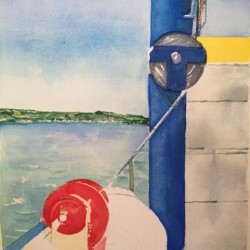I have one more artist I want to include here before I move on from painters who write on their canvases. I am waiting for permission to use a copyrighted image. So, in the meantime, I’ve printed some favorite poems recently, and Carol said she would like to see one of mine. So, this week it’s my two bird poems and my bird painting. Prayer was published in The Christian Century years and years ago.
Prayer
Into the space between looking and seeing
skimmed the owl you asked for.
One shade darker than dusk
you could have missed it all together
as easily as you forget
faith and fear become the same thing on different days.
But one broad sweep cleared the mist
and one sharp glint bounced back.
Be careful.
Lord of the sculpted sky and flight,
even the birds obey you.

Dove
In a world where appearance outstrips essence,
people seem to prize their porcelain preen,
these finely crafted big-bodied birds my mother, the lover of birds,
chases from her feeder. Stupid puny heads.
A waste of good seed on some softly shaded china doll
crested by an ugly nut so small that,
would you crack it, you would find inside its fragile walls
little room but that required by deep blue pools of looking,
and the flow of throat that feeds from them their murmurings.
Water washing sand.






